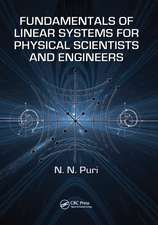Linear System Theory: Springer Texts in Electrical Engineering
Autor Frank M. Callier, Charles A. Desoeren Limba Engleză Hardback – 3 sep 1991
| Toate formatele și edițiile | Preț | Express |
|---|---|---|
| Paperback (1) | 955.40 lei 6-8 săpt. | |
| Springer – 17 oct 2012 | 955.40 lei 6-8 săpt. | |
| Hardback (1) | 961.86 lei 6-8 săpt. | |
| Springer – 3 sep 1991 | 961.86 lei 6-8 săpt. |
Preț: 961.86 lei
Preț vechi: 1173.01 lei
-18% Nou
Puncte Express: 1443
Preț estimativ în valută:
184.06€ • 193.05$ • 153.22£
184.06€ • 193.05$ • 153.22£
Carte tipărită la comandă
Livrare economică 01-15 aprilie
Preluare comenzi: 021 569.72.76
Specificații
ISBN-13: 9780387975733
ISBN-10: 038797573X
Pagini: 509
Ilustrații: XIV, 509 p.
Dimensiuni: 155 x 235 x 29 mm
Greutate: 0.92 kg
Ediția:1991
Editura: Springer
Colecția Springer
Seria Springer Texts in Electrical Engineering
Locul publicării:New York, NY, United States
ISBN-10: 038797573X
Pagini: 509
Ilustrații: XIV, 509 p.
Dimensiuni: 155 x 235 x 29 mm
Greutate: 0.92 kg
Ediția:1991
Editura: Springer
Colecția Springer
Seria Springer Texts in Electrical Engineering
Locul publicării:New York, NY, United States
Public țintă
ResearchCuprins
1 Introduction.- 1.1 Science and Engineering.- 1.2 Physical Systems, Models, and Representations.- 1.3 Robustness.- 2 The System RepresentationR(•) = [A(•),B(•),C(•),D(•)].- 2.1 Fundamental Properties ofR(•).- 2.2 Applications.- 2d The Discrete-Time System RepresentationRd(•) = [A(•),B(•),C(•),D(•)].- 2d.1 Fundamental Properties ofRd(•).- 2d.2 Application: Periodically Varying Recursion Equations.- 3 The System RepresentationR= [A,B,C,D], Part I.- 3.1 Preliminaries.- 3.2 General Properties ofR= [A,B,C,D].- 3.3 Properties of R when A has a Basis of Eigenvectors.- 3d The Discrete-Time System Representation Rd = [A,B,C,D].- 3d.1 Preliminaries.- 3d.2 General Properties of Rd.- 3d.3 Properties of Rd when A has a Basis of Eigenvectors.- 4 The System Representation R = [A,B,C,D], Part II.- 4.1 Preliminaries.- 4.2 Minimal Polynomial.- 4.3 Decomposition Theorem.- 4.4 The Decomposition of a Linear Map.- 4.5 Jordan Form.- 4.6 Function of a Matrix.- 4.7 Spectral Mapping Theorem.- 4.8 The Linear Map X ? AX+XB.- 5 General System Concepts.- 5.1 Dynamical Systems.- 5.2 Time-Invariant Dynamical Systems.- 5.3 Linear Dynamical Systems.- 5.4 Equivalence.- 6 Sampled Data Systems.- 6.1 Relation BetweenL- and z-Transforms.- 6.2 D/A Converter.- 6.3 A/D Converter.- 6.4 Sampled-Data System.- 6.5 Example.- 7 Stability.- 7.1 I/O Stability.- 7.2 State Related Stability Concepts and Applications.- 7d Stability: The Discrete-Time Case.- 7d.1 I/O Stability.- 7d.2 State Related Stability Concepts.- 8 Controllability and Observability.- 8.1 Controllability and Observability of Dynamical Systems.- 8.2 Controllability of the Pair (A(•),B(•)).- 8.3 Observability of the Pair (C(•),A(•)).- 8.4 Duality.- 8.5 Linear Time-Invariant Systems.- 8.6 Kalman Decomposition Theorem.-8.7 Hidden Modes, Stabilizability, and Detectability.- 8.8 Balanced Representations.- 8.9 Robustness of Controllability.- 8d Controllability and Observability: The Discrete-Time Case.- 8d.1 Controllability and Observability of Dynamical Systems.- 8d.2 Reachability and Controllability of the Pair (A(•),B(•)).- 8d.3 Observability of the Pair (C(•),A(•)).- 8d.4 Duality.- 8d.5 Linear Time-Invariant Systems.- 8d.6 Kalman Decomposition Theorem.- 8d.7 Stabilizability and Detectability.- 9 Realization Theory.- 9.1 Minimal Realizations.- 9.2 Controllable Canonical Form.- 10 Linear State Feedback and Estimation.- 10.1 Linear State Feedback.- 10.2 Linear Output Injection and State Estimation.- 10.3 State Feedback of the Estimated State.- 10.4 Infinite Horizon Linear Quadratic Optimization.- 10d.4 Infinite Horizon Linear Quadratic Optimization. The Discrete-Time Case.- 11 Unity Feedback Systems.- 11.1 The Feedback System ?c.- 11.2 Nyquist Criterion.- 11.3 Robustness.- 11.4 Kharitonov’s Theorem.- 11.5 Robust Stability Under Structured Perturbations.- 11.6 Stability Under Arbitrary Additive Plant Perturbations.- 11.7 Transmission Zeros.- Appendix A Linear Maps and Matrix Analysis.- A.1 Preliminary Notions.- A.2 Rings and Fields.- A.3 Linear Spaces.- A4. Linear Maps.- AS. Matrix Representation.- A.5.1 The Concept of Matrix Representation.- A.5.2 Matrix Representation and Change of Basis.- A.5.3 Range and Null Space: Rank and Nullity.- A.5.4 Echelon Forms of a Matrix.- A.6 Notmed Linear Spaces.- A.6.1 Norms.- A.6.2 Convergence.- A.6.3 Equivalent Norms.- A.6.4 The Lebesgue Spaces 1P and LP [Tay.1].- A.6.5 Continuous Linear Transformations.- A.7 The Adjoint of a Linear Map.- A.7.1 Inner Products.- A.7.2 Adjoints of Continuous Linear Maps.- A.7.3 Properties of the Adjoint.-A.7.4 The Finite Rank Operator Fundamental Lemma.- A.7.5 Singular Value Decomposition (SVD).- Appendix B Differential Equations.- BA Existence and Uniqueness of Solutions.- B.1.1 Assumptions.- B.1.2 Fundamental Theorem.- B.1.3 Construction of a Solution by Iteration.- B.1.4 The Bellman-Gronwall Inequality.- B.1.5 Uniqueness.- B.2 Initial Conditions and Parameter Perturbations.- B.3 Geometric Interpretation and Numerical Calculations.- Appendix C Laplace Transforms.- C.1 Definition of the Laplace Transform.- C.2 Properties of Laplace Transforms.- Appendix D the z-Transform.- D.1 Definition of the z-Transform.- D.2 Properties of the z-Transform.- References.- Abbreviations.- Mathematical Symbols.


































